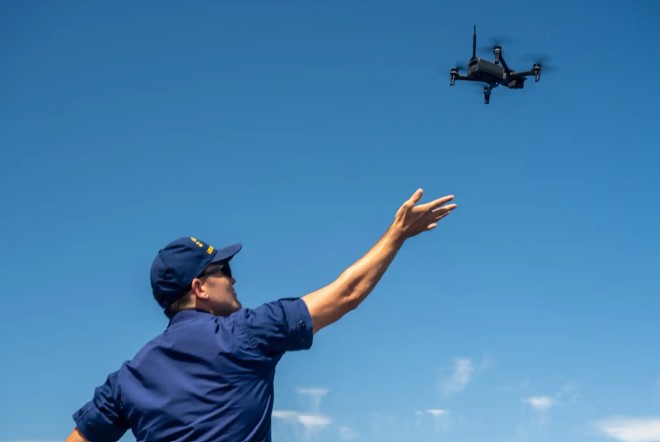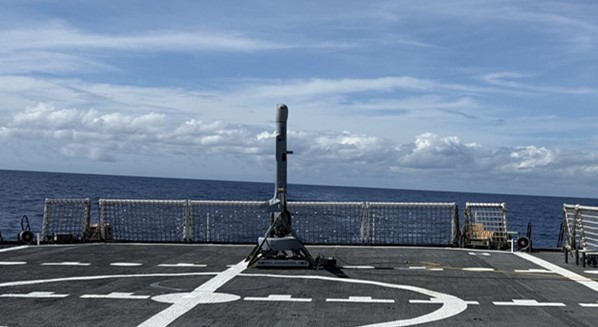Short-Range Unmanned Aircraft Systems

Use of SR-UAS started in 2018 with the initial fielding of UAS capability under the Group-1 UAS Prototype Program Initiative (GUPPI) with eight units and a few select mission sets. Quickly demonstrating the efficacy of the UAS capability, the GUPPI program expanded in 2019, adding nine more units and additional mission types to include search and rescue and law enforcement. The next phase was implemented in 2022, which included the requirement that only cyber-hardened National Defense Authorization Act-compliant “Blue” UAS could be purchased and fielded. By 2023 all initial GUPPI systems were removed from service due to cyber vulnerabilities.
Current systems
With the issuance of Department of Homeland Security policy addressing cyber security vulnerabilities of small UAS, the Department of Defense partnered with the Defense Innovation Unit (DIU) to develop a list of cyber-hardened, supply chain-verified systems and components known as the DIU Blue 1.0 list. From this first list of five systems, the SR-UAS program selected two systems: Parrot ANAFI USA for its ability to operate underway and Skydio’s X2D, which has 360-degree obstacle avoidance technology, electro-optical/infrared cameras and autonomous features such as object tracking, orbit and waypoint missions. The third and newest addition to the SR-UAS fleet is from the DIU Blue 2.0 list, the Skydio X10D. This upgraded system includes improved sensors, lighting, low light obstacle avoidance, longer flight time and the ability to operate underway.
Future
Following Executive Order 14307 and the Secretary of Defense memo titled “Unleashing U.S. Military Drone Dominance,” which removed some of the barriers to purchase and train with emerging UAS technology, DIU has been making rapid changes to update and expand the list of Blue systems. The Coast Guard is closely monitoring industry and is poised to integrate emerging new technology.
Medium Range Unmanned Aircraft Systems

The Coast Guard contracts MR-UAS capability as an innovative approach to provide a persistent airborne surveillance capability across the national security cutter (NSC) fleet. This approach meets a prescribed operational requirement for the NSC fleet, and use of UAS intelligence, surveillance and reconnaissance services expands maritime domain awareness and collects actionable intelligence on maritime hazards and threats.
An MR-UAS consists of an unmanned aircraft, its mission payloads, launch and recovery equipment, ground control station and control and data links.
Why this program?
The current program focuses on MR-UAS capability for the service's NSC fleet, but the 2024 contract can be used to expand support to additional cutter classes. For the NSCs, the Coast Guard requires an MR-UAS that can remain on station for extended periods. The contract awarded in 2024 includes flexibility to add additional payloads as well as detect and avoid capability to further enhance mission effectiveness.
How is the MR-UAS being acquired?
The program focuses on commercially available service technology with a proven track record in the maritime environment. The Coast Guard awarded a contract in June 2018 to Insitu for contractor-owned, contractor-operated UAS capability on three NSCs and options to outfit the rest of the NSC fleet in future years, with a total eight-year period of performance.
The Coast Guard awarded a second commercial services contract in June 2024 to Shield AI deploying a vertical take-off and landing MR-UAS. This contract has a five-year period of performance. A two-year contract overlap was included to ensure that UAS services are maintained during the vendor transition.
With just under 9,000 flight hours logged, UAS capability on the NSC has assisted in the interdiction and removal of illegal narcotics valued at more than $7.05 billion, the identification of more than 70 violations of illegal, unreported and unregulated fishing, and supported search and rescue cases resulting in more than 120 lives saved or assisted.
Long-Range Unmanned Aircraft Systems
The Coast Guard and U.S. Customs and Border Protection (CBP) operate the MQ-9A (Predator B) Guardian LR-UAS through a joint program office in Texas. This program started in 2008 as a pilot study to determine the feasibility of using LR-UAS to provide a long-endurance intelligence, surveillance and reconnaissance (ISR) capability to ground agents on the U.S. Southwest border. The joint program has expanded its capability into the maritime environment, providing ISR in the Gulf of Mexico.
The value of the LR-UAS in enhancing national security and public safety has been proven under the joint program. In fiscal year 2024, LR-UAS was deployed for over 11,000 flight hours. The LR-UAS contributed to the seizure of almost 35,000 pounds of illegal drugs, facilitated in the apprehension of almost 3,000 individuals and was instrumental in confiscating $13,633 and he14 illegal weapons. The LR-UAS has also supported search and rescue missions.
The Coast Guard received $266 million for LR-UAS in the One Big Beautiful Bill Act, which will be used to acquire four MQ-9B aircraft and associated equipment to augment joint CBP/Coast Guard operations in San Angelo, Texas.
News UAS: In the News
2025
July 31, 2025 - Coast Guard completes operational testing for new UAS capability
July 18, 2025 - Coast Guard conducts market research on maritime unmanned aircraft systems capabilities
2024
June 27, 2024 - Coast Guard awards contract to procure cutter-based unmanned aircraft system capability
2023
Dec. 18, 2023 - Coast Guard releases request for proposal for maritime unmanned aircraft system services
Jan. 25, 2023 - Coast Guard seeks information on UAS capabilities
2022
Aug. 12, 2022 - Coast Guard releases request for information for medium-range unmanned aircraft systems
2021
April 16, 2021 - Coast Guard completes UAS installations on two national security cutters
2020
Nov. 12, 2020 - sUAS for NSC continues accelerated production schedule
March 18, 2020 - Small UAS for NSC acquisition reaches milestone
2018
June 7, 2018 - Coast Guard Awards Contract To Procure Small UAS Capability For National Security Cutter
Feb. 8, 2018 - Coast Guard Releases Request For Proposal To Procure Small UAS For National Security Cutters
Jan. 29, 2018 - Small Unmanned Aircraft System Assists National Security Cutter Drug Interdictions
2017
Oct. 23, 2017 - Small UAS For NSC Acquisition Proceeds To Next Phase
Sept. 20, 2017 - Small Unmanned Aircraft System Assists Stratton Drug Interdictions
Aug. 30, 2017 - Coast Guard Releases Request For Information For Long-range And Ultra-long Endurance Unmanned Aircraft Systems
April 4, 2017 - Acquisition Update: Stratton Completes First Deployment With Small UAS
March 29, 2017 - Acquisition Update: Coast Guard Invites Industry Feedback On Small UAS Draft Request For Proposal
Feb. 10, 2017 - Acquisition Update: Coast Guard Members Complete Small Unmanned Aircraft System Training
Jan. 12, 2017 - Acquisition Update: Coast Guard Conducts Small Unmanned Aircraft System Testing On Cutter Stratton
2016
Oct. 11, 2016 - Coast Guard Begins Small Unmanned Aircraft System Installation On Cutter Stratton
June 28, 2016 - Acquisition Update: Coast Guard Selects Small UAS For NSC
2015
July 7, 2015 - Acquisition Update: Coast Guard RDC Conducts RAMPS Demonstration
2014
Dec. 18, 2014 - Acquisition Update: Coast Guard Continues UAS Research With Joint Fire Scout Demonstration
Dec. 8, 2014 - Coast Guard RDC Evaluates Unmanned Aircraft System From NSC
April 2014 - Acquisition Update: Coast Guard Concludes Last Phase of Small Unmanned Aircraft System Demonstration
2013
July 2013 - Acquisition Update: Coast Guard Nets Historic Drug Interdiction During Most Recent Phase of Unmanned Aircraft System Technology Demonstrations